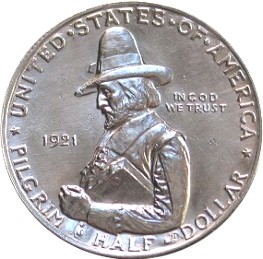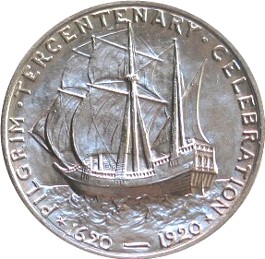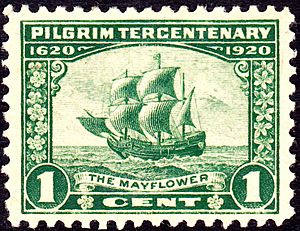Pilgrim Tercentenary half dollar facts for kids
| United States | |
| Value | 50 cents (0.50 US dollars) |
|---|---|
| Mass | 12.5 g |
| Diameter | 30.61 mm |
| Thickness | 2.15 mm (0.08 in) |
| Edge | Reeded |
| Composition |
|
| Silver | 0.36169 troy oz |
| Years of minting | 1920–21 |
| Mintage |
1920: 200,112 including 112 pieces for the Assay Commission (48,000 melted)
1921: 100,053 including 53 assay pieces (80,000 melted) |
| Mint marks | None, all pieces struck at the Philadelphia Mint without mint mark |
| Obverse | |
 |
|
| Design | Governor William Bradford |
| Designer | Cyrus E. Dallin |
| Design date | 1920 |
| Reverse | |
 |
|
| Design | The Mayflower |
| Designer | Cyrus E. Dallin |
| Design date | 1920 |
The Pilgrim Tercentenary half dollar is a special commemorative coin from the United States. It's a fifty-cent coin made by the United States Mint in 1920 and 1921. This coin was created to celebrate the 300th anniversary (called a tercentenary) of the Pilgrims arriving in North America.
The coin was designed by an artist named Cyrus E. Dallin. A congressman from Massachusetts, Joseph Walsh, helped make this coin happen. He thought a special coin would be a great way to support the anniversary events in Plymouth, Massachusetts. The idea for the coin quickly became a law on May 12, 1920.
Some people, like sculptor James Earle Fraser, didn't love the coin's design. But the government still approved it. At first, many coins were sold, but then sales slowed down. Because of this, thousands of coins from both years were sent back to the Philadelphia Mint to be melted down.
Contents
The Story of the Pilgrims
The Pilgrims were a group of English people who wanted to practice their Christian religion in a different way. They were called Brownist English Dissenters. Unlike the Puritans, who wanted to change the Church of England from inside, the Pilgrims wanted to completely separate from it.
Because King James I started to persecute (treat unfairly) these Separatists in 1608, many of them left England. They went to the Netherlands, hoping for more freedom. One of these people was William Bradford.
Life in the Netherlands became hard for the Pilgrims. They had few job opportunities and worried their children were losing their English language and faith. So, they decided to move to North America. A group of investors helped them pay for the journey.
They planned to sail on two ships, the Speedwell and the Mayflower. But the Speedwell was not strong enough for the long ocean trip. So, all the passengers crowded onto the Mayflower. The ship sailed from Plymouth, England, on September 6, 1620. It carried 102 passengers and 47 crew members.
So they left that goodly and plesante citie, which had been their resting place near 12 years; but they knew they were pilgrimes and looked not much on those things, but lift up their eyes to the heavens, their dearest cuntrie, and quieted their spirits.
The Mayflower reached Cape Cod (in what is now Massachusetts) on November 9, 1620. Two days later, the men on board signed the Mayflower Compact. This important document was an agreement to follow the rules made by the majority. It's seen as one of the first steps toward American democracy.
The Pilgrims had planned to settle further south, but they landed in a cold place. They were not ready for the harsh Massachusetts winter. Half of them died before spring arrived. In 1621, they met Samoset and Squanto, two Native Americans who spoke some English. Squanto taught the Pilgrims how to grow corn, which helped them survive.
Plymouth Colony grew slowly. In 1691, it became part of the larger Province of Massachusetts Bay. After the first governor died, William Bradford was elected. He served many terms and helped the colony become successful. His writings, Of Plymouth Plantation, tell us a lot about the Pilgrims' daily lives.
In the 1920s, the government didn't sell commemorative coins directly to the public. Instead, they sold them to a special organization at face value. This organization would then sell the coins for a higher price. For the Pilgrim half dollar, the money raised went to the Pilgrim Tercentenary Commission. This commission used the profits to pay for the anniversary celebrations.
Making the Coin Law
Congressman Joseph Walsh from Massachusetts introduced the idea for the Pilgrim half dollar in the House of Representatives on March 23, 1920. The bill went to a special committee that deals with coins.
The committee held meetings to discuss this coin and another one for Alabama. The Treasury Department was a bit worried about making too many different coin designs. They thought it might make it easier for people to create fake coins.
Walsh explained that a commission was already planning celebrations for the 300th anniversary of the Mayflower landing. These events would happen in December 1920 and the following summer. The main goal was to improve the area around Plymouth Rock. Walsh got the idea for a coin after seeing a report about a coin for Maine. He remembered that special coins were made for the World's Columbian Exposition in 1893.
Walsh asked for 500,000 coins, more than for the Alabama coin, because he felt the Pilgrim anniversary was very important. Another congressman suggested 300,000 coins instead, and Walsh agreed. The committee approved the bill with this change.
On April 21, 1920, the House of Representatives discussed the Pilgrim coin bill. Some questions were asked about why so many coins were needed. Walsh explained it was a 300th anniversary, which was a bigger deal than a 100th anniversary. The bill passed the House without anyone voting against it.
The next day, the bill went to the Senate. On May 3, Senator George P. McLean asked the Senate to vote on the coin bills quickly. He said it was important because the anniversaries were already happening. All three coin bills, including the Pilgrim one, passed the Senate. President Woodrow Wilson signed the Pilgrim bill into law on May 12, 1920.
Designing the Coin
The Pilgrim Tercentenary Commission created some early sketches for the coin. Then, Cyrus E. Dallin, a sculptor known for his works about Native Americans and Pilgrims, turned these sketches into detailed models. Since the law was passed in May 1920, and they wanted the coins ready soon, Dallin had to work very fast.
Dallin finished his models in August 1920. The designs were then sent to sculptor James Earle Fraser for review. Fraser thought the lettering on the coin was a bit rough. He wished there was more time to make changes. However, the Treasury Department approved the designs anyway.
What the Coin Looks Like
The front side of the coin, called the obverse, shows a picture of William Bradford. He is wearing a hat and holding a Bible under his arm. He looks like he is thinking deeply. On Dallin's original models, the words "HOLY BIBLE" were on the book, but they were removed.
The initial "D" was placed under Bradford's elbow. This "D" was probably added later using a tool meant for the mint mark "D" for the Denver Mint. Historians say Bradford's clothing looks like what people wore back then. However, no real pictures of William Bradford exist, so this is an artist's idea of him.
The back side of the coin, called the reverse, shows the Mayflower ship sailing with its sails full. Coin experts have noticed one small mistake: the ship has a triangular sail called a flying jib. This type of sail was not used during the Mayflower's voyage. However, this mistake was not made on the one-cent stamp issued for the anniversary. The words and dates around the ship explain what the coin is for.
An art historian named Cornelius Vermeule said the Pilgrim half dollar is "a masterpiece." He thought the picture of Bradford might have been inspired by another famous sculpture called The Puritan. He also felt that the ship on the coin was much better than earlier ship designs on other coins. He said, "Seen from the stern on the waves, the Pilgrims' ship is impressive."
Making and Selling the Coin

The Philadelphia Mint made 200,112 half dollars in October 1920. A few extra coins were made for testing by the Assay Commission. These coins were sent to a bank in Boston, which sold them to the public for $1 each. The money earned went to the tercentenary commission. People could buy the coins through banks in Boston or Plymouth.
Sales of the 1920 coins were very good at first. The commission still had some coins left from the authorized amount, so they ordered 100,000 more in the spring of 1921. These were made in July 1921. The 1921 coins have the year "1921" added on the front, next to Bradford. This was done because a law required the year of minting to be on the coin.
Soon after, a recession (a time when the economy slows down) began. Sales of the coins dropped a lot. Tens of thousands of coins from both 1920 and 1921 were not sold. The tercentenary commission sent 48,000 of the 1920 coins and 80,000 of the 1921 coins back to the Mint to be melted.
Over the years, the value of both Pilgrim half dollars has gone up. The 1921 coin is rarer because fewer were sold and more were melted. In 1936, a 1920 coin sold for $1.75, and a 1921 coin sold for $8. By 1980, the 1920 coin was $275, and the 1921 coin was $800. Today, depending on its condition, a 1920 coin can be worth between $85 and $650, and a 1921 coin between $170 and $850. In 2014, a very rare 1920 coin sold for $7,344 at an auction.
Some coin experts believe the Pilgrim coin was the first time a commemorative half dollar was made over two years. This was done to encourage coin collectors to buy both coins to complete their sets.




